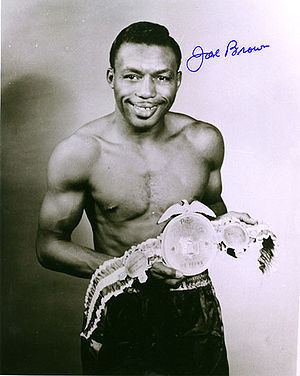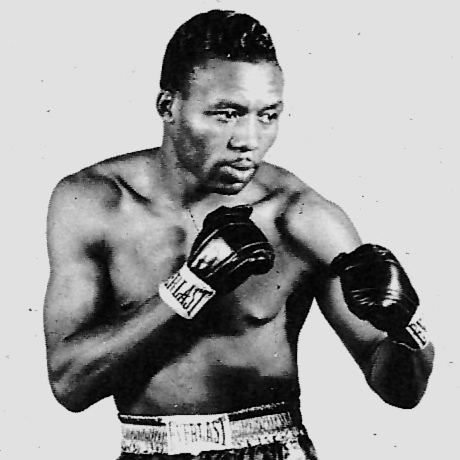Nickname(s) Old Bones Wins 105 Height 1.7 m Nationality American Role Boxer Total fights 165 | Reach 68 in (173 cm) Name Joe Brown Wins by KO 47 Martial art Boxing | |
 | ||
Born May 18, 1926 ( 1926-05-18 ) Died December 4, 1997, New Orleans, Louisiana, United States | ||
Joe brown beautiful boxing
Joe Brown (May 18, 1926 – December 4, 1997) was an American professional boxer who won the world lightweight title in 1956, making 11 successful defenses before losing his crown to Carlos Ortiz in 1962. Brown was a classic boxer and a knockout puncher. Known as the 'Creole Clouter' and Joe 'Old Bones' Brown, he was managed by Lou Viscusi and named The Ring's 'Fighter of the Year' for 1961. Brown was inducted into the International Boxing Hall of Fame in 1996.
Contents
- Joe brown beautiful boxing
- Joe brown vs wallace bud smith i part 1
- Early life and career
- World Champion
- Beyond glory
- References

Joe brown vs wallace bud smith i part 1
Early life and career
Born into poverty in Baton Rouge, Louisiana, USA, on May 18, 1926, Brown started work as a grocery assistant, moved into carpentry and then embarked on his professional boxing career at the age of seventeen. He recorded only one contest – winning a four-round decision against Leonard Caesar on September 3, 1943 – before being called up for wartime service. During his 21 months with the US Navy, Brown took part in seven Pacific invasions and won the All-Service Lightweight Championship. He was honourably discharged from the service in 1945.
The resumption of Brown's career was initially disappointing. Suffering a third-round knock-out by Melvin Bartholomew in July 1945, Brown did not fight again until January 1946, when he lost on a decision over five rounds to Leonard Caesar. Some reward came a mere seven days later when Brown out-pointed Johnny Monroe, but his career over the following three years was, at best, chequered.
The impetus for Brown's ultimate success seems to have been provided by a crushing defeat at the hands of the future National Boxing Association Welterweight Champion, Johnny Bratton, late in 1948, immediately followed by a short spell away from the ring. In 1949, Brown actually went unbeaten and, over the next seven years, he steadily climbed the Lightweight rankings, defeating along the way such notable boxers as Virgil Akins, Isaac Logart and Teddy 'Redtop' Davis.
These fruitful times were not, however, without their difficulties. The skilful Brown, standing a lanky 5 feet 7½ inches, with a long reach and solid left hand, came to be viewed as dangerous – too dangerous by some astute managers who frequently appeared to steer their charges away from meeting him. Several times, Brown hung up his gloves in despair during his thirteen-year wait for a shot at the title. When it came, at the comparatively advanced age of 30, he did not disappoint.
World Champion
Brown earned his chance for the Lightweight Championship of the World by out-pointing the reigning champion, Wallace 'Bud' Smith in a non-title bout held in Houston, Texas, in May 1956. Four months later, on August 24 and in front of his home crowd, Brown defeated Smith by way of a split decision over fifteen hard-fought rounds. Confirmation of Brown's superiority came early in the following year when, defending the Championship for the first time, he knocked Smith out in eleven rounds.
Once Champion, Brown hoped that his newly acquired status would confer the riches and popular recognition denied to him for so long. Yet, as George Gainford (manager of the charismatic and handsome Sugar Ray Robinson) noted, the name 'Joe Brown' was hardly inspirational. Realising this, Brown attempted to solve his problems by billing himself as Joe 'Old Bones' Brown. The gimmick worked and he became something of a draw for the remainder of his Championship career.
In all, Brown made eleven successful defences of his title – a record until Roberto Durán's arrival in the division – and remained Champion for almost six years. After demolishing Smith, Brown beat Orlando Zulueta, Joey Lopes, Ralph Dupas, Kenny Lane, Johnny Busso, Paolo Rosi, Cisco Andrade, Bert Somodio and Dave Charnley (twice). Brown's re-match with Charnley, was named The Ring's Fight of the Year for 1961.
Nemesis came in the form of the great Carlos Ortiz from Puerto Rico. Ortiz – intelligent, agile and ten years Brown's junior – stepped down from the Junior Welterweight division where he had been king until out-pointed by Duilio Loi, to focus on the richer pickings to be had amongst the world's top Lightweights. He met Brown in Las Vegas on April 21, 1962, and took the ageing Champion's title after fifteen lackluster rounds to begin his own lengthy domination of the division.
Beyond glory
Brown fought on for another eight years, before retiring in 1970, at the age of 44. His best days long gone, he suffered almost as many defeats as he scored victories. In reflecting on the close of Brown's career, Henry Cooper has written that there came to be "little pride left in his performances" as he tried to compensate "for all the hungry years when he had been forced to fight for peanuts" (Cooper, 1990). Joe Brown later became a trainer in New Orleans, Louisiana, and led some fighters to become professionals, such as Gregory E. Haines, of Slidell, Louisiana.
Joe Brown died in New Orleans, USA, on November 21, 1999.
